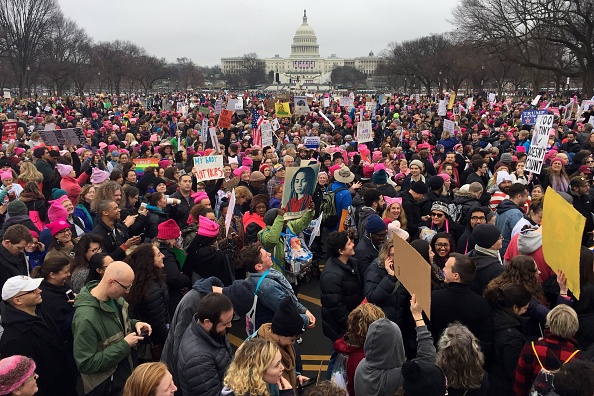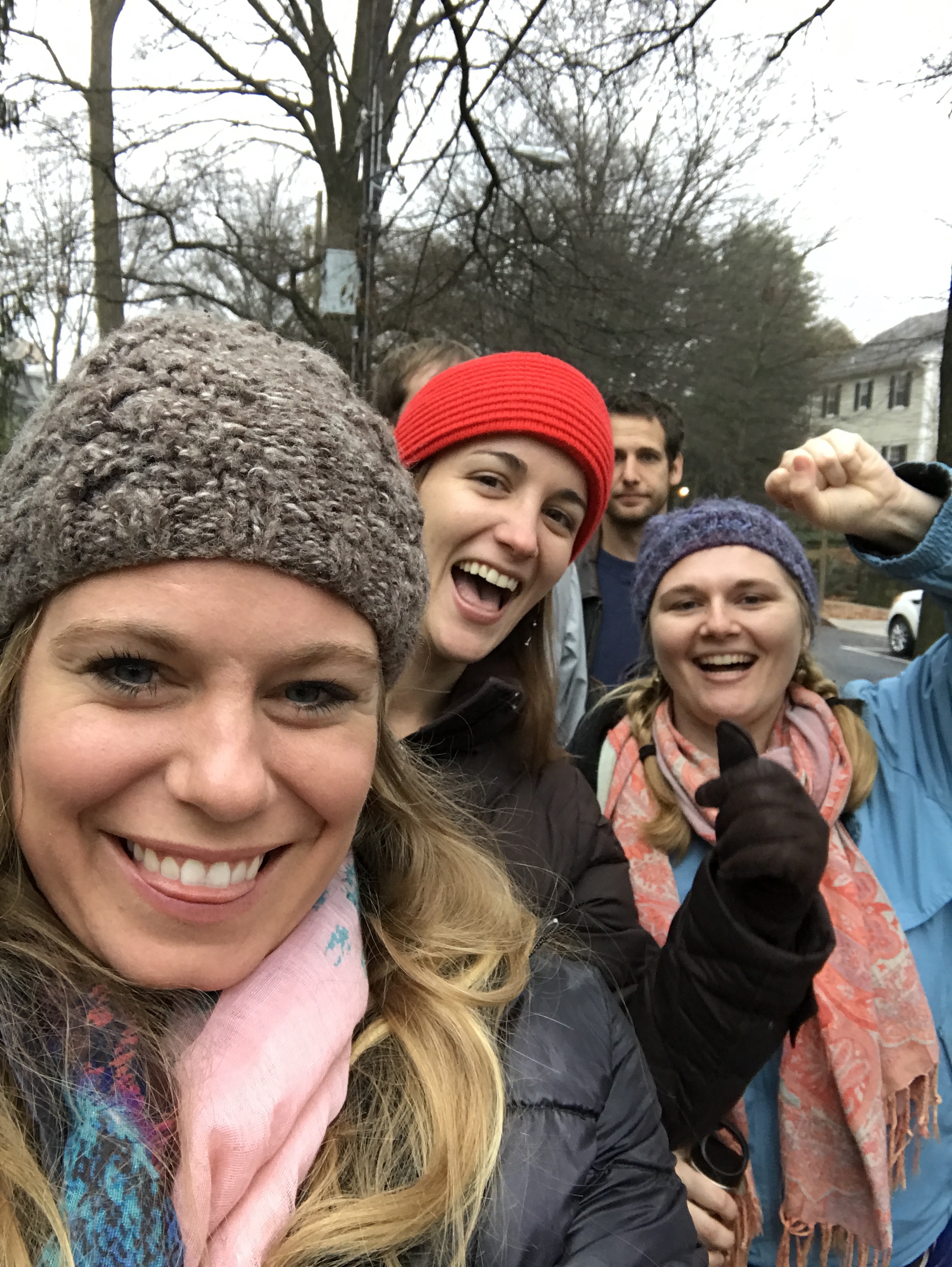
Brie Noel Taylor is a content strategist and painter who lives California. She attended the Women’s March in San Francisco.
The 2016 presidential race felt like an onslaught of America’s worst politicking with gender attacks, political infighting, class warfare, religious scapegoating and racism so thinly-veiled it seems too generous to call it dog-whistle politics. The Women’s March felt like an immediate and necessary salve for this. I had a to go. It had a theme. It had a manifesto. It allowed me to put my body in the streets, surrounded by thousands of other bodies each full of their own fire. It was imperfect, but it was action.
Growing up as a millennial, I’ve had near-constant access to technology and the 24-hour news cycle. This sounds empowering, but it’s not. It’s overwhelming. I studied government, and then environmental policy in graduate school, and yet I felt unsure of how to act in any meaningful way. I’ve seen millennials characterized as politically apathetic; my take is that we feel politically impotent. We’re inundated with news about how our social and political structures fail our most vulnerable communities, and yet we’re raised in a country that has an inherent distrust of government and offers no clear alternative for individual action.
I don’t want to wax poetic in describing the March as a watershed moment. Individuals and groups have been doing this type of work constantly and tirelessly. Black Lives Matter protests were happening before the Women’s March, and have happened since. But the shared shock at the size of the Women’s March was probably due to the fact that many groups in America are able to live oblivious to — or at least greatly sheltered from — the woes affecting other groups who don’t look like or live near them. It made the sudden grouping of millions of individuals in social protest feel like a flash flood.
In many ways, the Women’s March did feel like the rewinding of a stalled clock. Women marched, and then called their Senators weekly, and encouraged others to do the same. They marched, and then they donated. They marched, and then they volunteered. They marched, and now they’re running for office.
For me, I marched, and then I painted.
The “pink pussy hats” of the Women’s March felt like a a reclamation of the word pussy, and the derided-as-feminine color pink, and the ignored-as-feminine practice of textile art, all rolled into a symbol of feminine power.
This reminder of art as symbol and as a uniting force has shaped my post-march activism. After the election, and throughout 2017, I created paintings inspired by nature, sold them, and donated the profits to groups like Planned Parenthood and the ACLU. I’d found a way to support groups doing important work while bringing beauty into the world.
In the year since the inauguration I’ve watched, horrified but unsurprised, as President Trump has put into policy the rhetoric that got him elected. But I’ve also watched women and their allies find new ways to stay informed and take action. I paint to act, and I donate, and call my Senators. I’ve seen people volunteer, and read, and write and hold difficult conversations to learn from people that don’t share their views.
The election has been criticized as dividing the country. This may be true. But it may also be true that so much of the country that was inactive, either because we did not know how to act, or because we wrongly believed these issues did not apply to us, has now been energized. We are a clock that has been wound, and we march, often together, sometimes apart, with a steady throng, still imperfect, but learning as we go.
Sophie Elgort is a fashion and portrait photographer who lives in New York. She attended the Women’s March in Park City, Utah.
After Donald Trump won the election last year, I felt an overwhelming sense of despair. To be completely honest, I was someone who had always showed up to vote, but was never overly involved or vocal about politics. After Trump was elected into the most powerful office in the world, I realized, too late, that just showing up to vote every four years wasn’t enough. I immediately looked for answers and spoke to friends who had donated their time and skills to the 2016 presidential election. I wanted to understand how I could become part of the difference or movement that would never let something like this happen again. I craved a sense of community and other people who also wanted to stand up for what they thought was right. So when I heard about the Women’s March I knew that I had to go. As a photographer, I attend the Sundance Film Festival each year in January, so I was glad to hear that Chelsea Handler was leading a Women’s March there. The atmosphere of community, empowerment and support that I experienced that day has continued to pick up momentum throughout this past year.
Jessica Williams was just one of the speakers at the Park City, Utah march whose words resonated with me. As she put it,”The silver lining of this election is that we are here on this early ass morning in literally 21 degrees supporting each other.” Over this past year, one of the most important things that has continued on after the Women’s March has been people supporting and standing up for one another and working to make sure everyone feels that they have a safe space to speak their truths. Just look at the way people have rallied behind those who had the courage to speak up and say #MeToo. And it’s this support that’s more important than ever now to counter President Trump’s tremendous lack of respect for others.

Susan Fowler, a former engineer at Uber who wrote a scathing essay on how the company handles sexual harassment, recently said, “There’s something really empowering about standing up for what’s right.” Even though we have a long way to go, I think we’re taking steps in the right direction by standing up for each other, and for what is right, even on the issues that don’t affect us directly.
Personally, after noticing a lack of diversity on the fashion runways, I launched a non-profit called Through Our Lens with my friend Carolyn Pride. It’s an organization that provides mentorship to high-school aged girls from underserved communities through photography in order to increase diversity in front of and behind the camera.
As I’m writing this piece on Martin Luther King Jr. Day, one of his quotes is resonating particularly strongly with me — “In the end, we will remember not the words of our enemies but the silence of our friends.”
I am deeply offended, outraged in fact, by Trump’s discriminatory comments and it’s not enough to feel this way and not speak up. But the sense of community, empowerment and support that was in the air a year ago all around the world gives me hope.
As Jessica Williams said during the Women’s March: “I stand with you, I hope that you stand with me.”
Rebecca Burton is a communications coordinator in Florida. She attended the Women’s March in Washington, D.C.
In the few days after the 2017 Women’s March on Washington, I realized I was not as #woke as I thought. When news of the Women’s March on Washington spread like a wildfire on Facebook, a rush of adrenaline overcame the immense dread I — and a lot of the country felt – when it sank in that the Obama era was officially over.
It was a sort of cathartic to read about others’ reactions. My inner circle of online friends tend to lean left, so anger about the outcome dominated my timeline and only amplified mine. I instantly clicked “going” on the event page. I had a chance to be a part of history.

The sheer magnitude of the crowd was phenomenal. Metro stations waived fares to alleviate crowding. Seas of people flooded the streets. Celebrities and activists took to the stages to air their grievances.
In the days following, one particularly uncomfortable criticism of the march poured in. The event’s early organizers and most of its attendees were white women like me. Fifty-three percent of us voted for Trump. Only four percent of black women voted for him.
This was on us. We were late.
The Women’s March on Washington sparked a new sense of civic responsibility. I don’t think I’m alone in thinking this. Never in my lifetime have I seen this amount of engagement in our democracy by young people like me. But the march also caused me to realize certain things and recognize that the gender discrimination I face is exponentially worse for women of color since they face racial and gender biases every single day.
I argue that the Women’s March was a precursor to the current #MeToo movement. I say current, because we can’t forget that Tarana Burke originally started the #MeToo movement in 2007.
While women in Hollywood have helped magnify the message, the constant allegations flowing in across industries prove that gender inequality is still rampant. But, I’m hopeful change is on the way. We cannot forget that in many industries, women still do not have the chance to speak up. They could face dire consequences if they choose to report their abuse. We cannot leave these women out of the conversation.
Since the Women’s March I have a broader perspective. I try to boost the voices of women and men who don’t have the same privileges that I do, and I hope that those who have more privileges than me return the favor.
More Must-Reads from TIME
- Cybersecurity Experts Are Sounding the Alarm on DOGE
- Meet the 2025 Women of the Year
- The Harsh Truth About Disability Inclusion
- Why Do More Young Adults Have Cancer?
- Colman Domingo Leads With Radical Love
- How to Get Better at Doing Things Alone
- Michelle Zauner Stares Down the Darkness
Contact us at letters@time.com